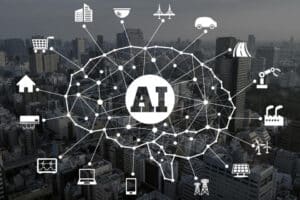
AI technology is unique in that it is flexible in application. It can be used to improve processes, enhance interactions, and solve problems that, until recently, could only be performed by humans. AI’s advanced abilities include natural language processing (NLP), machine learning, machine perception, and enhanced analytics.
The list below details 29 cutting-edge applications of artificial intelligence.
Natural language processing
Natural language processing (NLP) is a sub-category of AI that attempts to bridge the gap between human and computer communication. AI-enabled systems such as IBM’s Watson use NLP to understand and respond to the nuances of human language. This allows for more accurate analysis of data sets and communication of insights.
- Customer interaction chatbots — Chatbots are computer programs that are commonly used to interact with customers by audio or text. Conversica, for example, is a virtual sales assistant that communicates persistently and politely with prospective sales leads. Conversica uses email to engage, qualify, and follow-up with leads, allowing the sales team to focus their efforts on closing deals.
- Financial chatbots — In the financial industry, chatbots such as aLVin are used to interact with brokers. They can answer questions, understand intent, and direct brokers to their desired products and information.
- Virtual assistants — Beyond chatbots, AI can power more complicated virtual assistants that can recognize client needs and complete various tasks. Expensify‘s virtual assistant, Concierge, assists in the automation of expense reports and travel arrangements for companies. It can inform clients of real-time price changes and can even file receipts on their behalf.
- Communication systems – AI-powered communication systems can also be used to manage relations between peers and stakeholders. CrystalKnows, a personality detection software, uses NLP to evaluate LinkedIn accounts and develop a profile of how to most effectively speak to, work with, or sell to an individual. Crystal can even draft emails to anyone based on the preferred tone suggested by his or her online presence.
- Legal assistants — The language processing capabilities of AI assistants can be tailored to a specific industry. LegalRobot’s AI assistants are designed to review legal documents and make suggestions for language clarity and strength.
- Cognitive retail – Virtual assistant capabilities can be integrated with other customer relationship management products to provide in-person levels of service via online platforms. The North Face‘s personal web-shopper, XPS, uses NLP to understand customer need as would a human representative. It then uses machine learning to make informed product recommendations based on customer history, location, and other data.
- Personal assistants – AI can also be used on a personal device to simplify daily tasks. Gluru technology, for example, is used to power a task management application that uses NLP to analyze a user’s conversational data, such as their email. This app can identify tasks, generate a personalized to-do list, and even provide actionable buttons to complete each task.
- Web speech – New language-based technological advancements in AI can improve the web navigation and searching experience. These web speech APIs integrate voice recognition technology, syntactical analysis, and machine learning to seamlessly convert voice to text and vice versa. This click- and typing-free internet interaction can improve information accessibility for those with a disability or low technological acumen.
Machine learning
Machine learning is an application of artificial intelligence that allows systems to process data and learn to improve the performance of a specific task without explicit programming. Deep learning is a form of machine learning that mimics human learning patterns to gain an understanding of unstructured data sets and generate intelligent decisions.
- Medical decision making — Deep-learning programs such as Enlitic can optimize physician decision making by analyzing a patient’s past medical history, diagnostic information, and symptoms to provide actionable insights. These programs learn as they process data, improving their ability to identify diseases and provide treatment planning.
- Healthcare analytics — Deep learning can also be used to compile, analyze, and interpret collaborative data. Flatiron, for instance, has developed a cloud-based platform for healthcare professionals that compiles insights, empirical data, and patient experiences to improve oncological care on a real-time basis.
- Bioinformatics – In the field of bioinformatics, scientists use AI-software to identify patterns in large data sets, such as sequenced genomes and proteomes. This analysis can help in the development of new drugs to tackle diseases by determining which proteins are encoded by a certain gene. Atomnet is a deep-learning technology that analyzes the structure of proteins known to cause disease and designs drugs accordingly.
- Emotional detection —Emotional detection systems powered by AI can detect human emotions without visual input. Researchers at MIT have developed EQ Radio, a system that learns to identify human emotions based on heartbeat data collected by wireless signals. This technology may one day be used by smart homes to detect if a resident is experiencing a heart attack.
- Fraud detection — Fraud prevention has always been a major challenge for the financial industry. PayPal and other eCommerce companies have started to use deep-learning fraud-detection algorithms to monitor customers’ digital transactions and identify suspicious behaviours. A study by LexisNexis found that this deep-learning approach to security has reduced PayPal’s fraud rate to 0.32% of revenue, a 1% improvement over the industry average.
- Cyber Security — AI-enabled cybersecurity programs analyze and organize internal network data to identify potential threats. The security program RecordedFuture uses machine learning and NLP to contextualize information and provide actionable analyses.
- Procurement optimization – Companies can use AI internally to enhance business operations such as procurement. Tamr, a data unification software, uses machine learning to clean, analyze, and sort procurement data. It identifies savings opportunities, bundles spending across business units, and exposes supplier risk.
- Customer interactions — While NLP allows virtual assistants to interact easily with customers, deep learning allows them to locate and provide the desired information. The AI model DigitalGenius analyzes historical customer service transcripts in order to recognize successful customer interactions. This allows the model to predict meta-data for new cases and provide suggestions for automated customer responses.
- Optimized gaming — The gaming industry, previously focused on the level distinctions of “easy,” “medium,” or “hard,” is now using AI technology to develop self-optimizing and -evaluating games. These new AI-powered games keep players engaged by continuously adjusting difficulty and strategy to suit player ability.
- Military planning — In a military setting, AI can be used to increase deployment efficiency. Autonomous machines (including drones and satellites) share data in real time to develop actionable strategies. The U.S. military AI system JADE evaluates historical data combines information with learned reasoning and presents suggestions to execute large-scale plans in minimal time.
Machine perception
Machine perception is the ability of a system to simulate the human perception of the world. AI uses machine perception to extract information from different data sources. Computer vision is a type of machine perception that allows AI to extract information from images.
- Medical imaging — Computer vision represents a huge technological advancement for medical imaging and preventative care. The diagnostic program Zebra Medical Vision collects and analyzes medical scans for various clinical identifiers. It then accesses a database of millions of scans, enabling it to provide critical information such as the location of a tumour or a patient’s risk of cardiovascular disease.
- Manufacturing — The manufacturing sector is increasingly turning to robotics to speed up repetitive tasks. AI-enabled robots use computer vision to complete tasks and to adapt to changing environmental conditions, broadening the types of tasks available to robots and preventing costly mistakes on the assembly line. Fanuc‘s Gakushu robots use computer vision and a machine learning software to collect and evaluate data for path, speed, and task optimization in aerospace manufacturing.
- Service industry – Some AI-enabled robots can not only understand human language but can recognize human emotions. Using computer vision, Softbank‘s humanoid robot Pepper can interpret facial expressions as human emotions and generate responses accordingly. Pepper can also recognize and remember individual faces and preferences. It is primarily used as a greeter in Japanese office buildings, restaurants, banks, and stores.
- Financial industry — In the financial industry, AI programs can learn to identify potential high-yield customers, to recognize fraud, and even to forecast changes in stock trends. To further reduce fraud, the financial application Face++ uses computer vision for facial recognition to secure users’ financial transactions.
- Autonomous delivery – Companies are increasingly using AI for commercial navigation purposes. Autonomous delivery systems, such as Amazon‘s delivery drones and Domino‘s Robotic Unit, use computer vision to efficiently navigate obstacles and optimize routes. Beyond commercial delivery, Matternet’s autonomous drone network in Switzerland aims to reduce medical testing times by flying diagnostic materials between hospitals and labs.
- Transit safety — AI technology is paving the way for autonomous cars and accident-free transit systems. The combination of deep learning and computer vision allows cars to observe and safely interact with the surrounding environment. Road safety can be further increased by AI-enabled navigation systems, which alert drivers to potential accidents and suggest alternative navigation routes.
- Geospatial analytics — Geospatial analytics use computer vision to gather and compare satellite imagery with historical data in order to develop insights. Using these insights, AI-enabled satellites can track economic trends from space. Orbital Insight, for example, predicts retail sales based on satellite images of retail store parking lots.
- Childcare — AI devices use computer vision to recognize faces and navigate around obstacles, but a new Google patent suggests they can even be used to provide childcare. Google’s AI babysitter system learns to recognize different features of a home and to differentiate between family members. The system can recognize when a child has been left alone for too long, or has wandered dangerously close to a socket, and alerts the parents accordingly.
Predictive analytics
Predictive analytics are used by programs to analyze historical data in order to predict future outcomes. When combined with AI platforms, analytic ability increases in speed, scale, and application.
-
- Marketing — Some predictive models can be used to analyze consumer data and inform marketing decisions. Magnetic, for instance, can predict the most effective advertisement to present a particular consumer and can choose to present the selected advertisement to the consumer without human supervision.
- Data extraction — Data-extraction programs use AI to analyze and extract specific information from documents. Xtracta, for example, allows various retail applications to extract data from receipts. This information, combined with predictive analytics, generates useful statistical reports and relevant buying suggestions for the application user.
- Social Network Analytics — Social networks can provide valuable marketing data, but also produce linguistically complicated datasets. In order to produce usable information, user profiles must be semantically analyzed using NLP. Companies can then use predictive algorithms to identify a customer’s preferences and web navigation patterns in order to provide targeted web advertising.
Development of AI technologies is actively being encouraged through projects like Soar—a cognitive architecture project aimed at developing computational building blocks for intelligent agents—and OpenCog—an open-source software project intended to create a framework for artificial general intelligence. Through such collaboration, AI capabilities continue to advance, thus expanding application potential.
Is your organization ready for AI? Read more about our AI consulting capabilities here.
By: Jenya Doudareva, Associate & Lokesh Patil, Associate
Read more of our insights on artificial intelligence
Find out more about transforming your business with artificial intelligence and automation.
CONNECT WITH US




